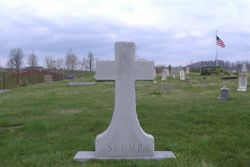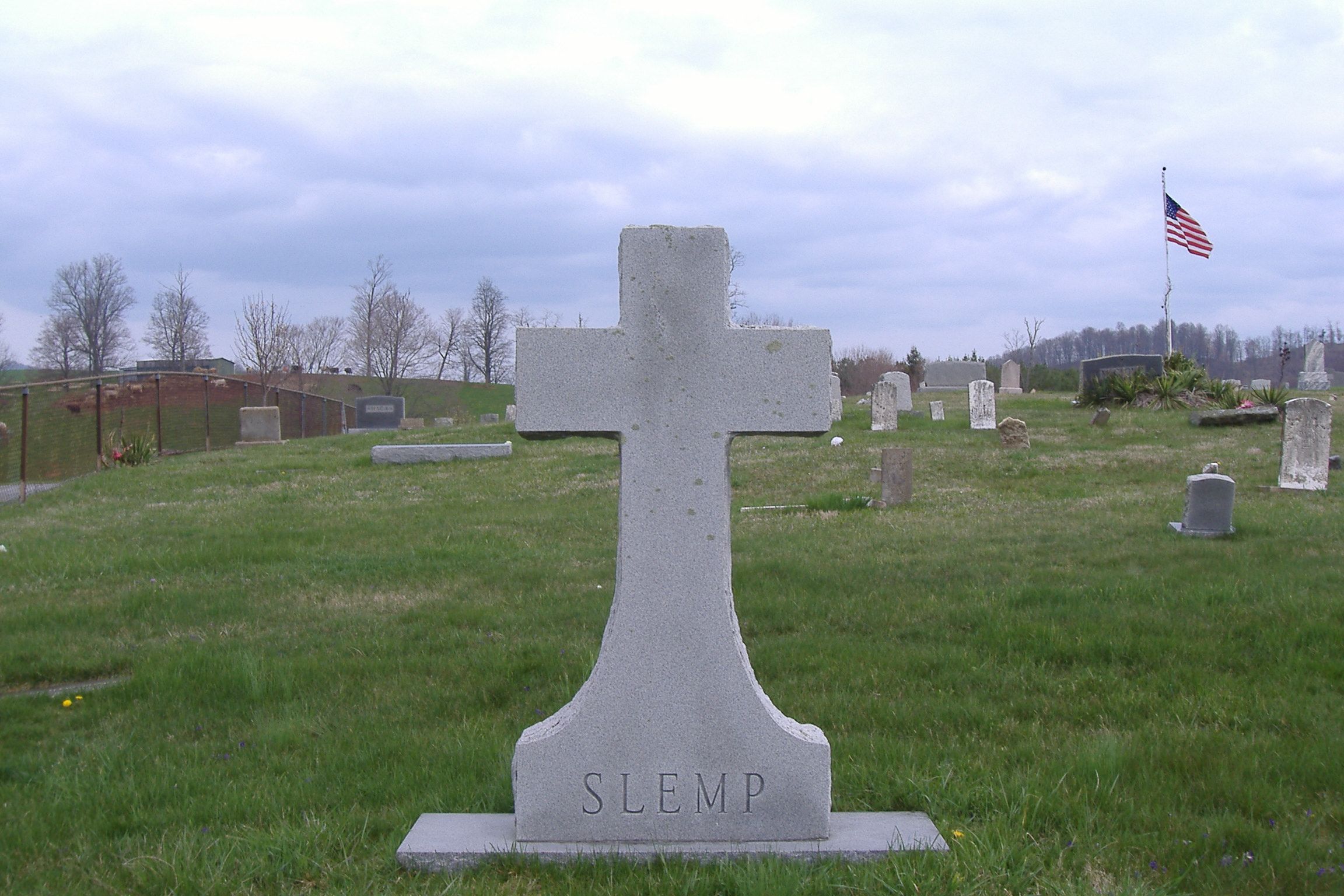Family legend has it that the Schlemps sailed from Amsterdam, Holland, were nine months on the ocean; that their son Jacob was born on the boat, and that they landed at Norfolk, Virginia. Tradition is that they landed at Norfolk, went to Accomack County for a time and then came to Rye Valley, Sugar Grove, Smythe Co., VA. The location was then in Wythe County and Wytheville was the county seat.
Frederick Schlemp served as a Private in Capt. William Love's Company, Montgomery Co., VA. during the Rev War. (Va. Hist. Mag. XLVII No. 2) Wm Love's Company was stationed at Ft. Robertson Jun-Oct 1782. (Per birth dates of children, Schlemp was never far from home, at least not for very long.) He is listed as a patriot on the Smythe Co., VA Rev. Patriots monument on the Smythe Co., VA Courthouse lawn.
Survey Book I, Wythe Co., VA. page 331:
Surveyed for Federick Slimp, 250 acres of land by virtue of an entry made in the Surveyors office of Montgomery County the 17th of June 1783. Certificate from the Countys for the district of Washington and Montgomery Countys for 250 acres lying in Wythe County on the head waters of the South Fork of Holston.
"In 1804 a certain Frederick Slemp took up land on a mountain creek above Sugar Grove and the creek took his name and has kept it." - Smythe Co., VA History & Traditions by Goodridge Wilson.
1815 Fred Slemp estate on S Fork Holston River Valley, 25 mi SW of courthouse.
Ironworker. His sons built the first forge west of the blue ridge mountains (for which special land grants were awarded). This was very primitive work, digging iron from the ground and smelting it, casting it into "pigs" which were transported to larger towns to be "wrought" into useable goods. Cutting the huge volumes of wood to make charcoal to melt the iron out of the ore was horrendously grinding work. When the Bessemer process, (much more efficient) was introduced in 1855, most of these small ironworks were put out of business.
Johannn Frederick Schlemp's will is dated February 17th, 1807, and was recorded In June, 1807 at the Courthouse at Wytheville, Virginia. This will conveys property to and names his wife, Mary, and four sons and five daughters. This will is signed Frederick Slimb, written in German script. In his will he stated he owned a one-third interest in the Iron Works on Roan Creek. This he directed to be sold and equally divided between his wife (Mary Metz Schlemp), four sons and five daughters.
The will mentions "my two youngest sons Frederick and John." Frederick was made executor. He lived and died at the old homestead In Smythe County Virginia. The two oldest sons, Jacob and Michael and at least two of his daughters, with their husbands moved to Johnson County, TN.
There, his widow Mary followed to end her life at the home of her daughter Virginia Barbary (Schlemp) Shoun, with four or five of Mary's children surrounding her at her death.
There are many evidences that both Frederick Schlemp and his wife, Mary, were from cultured, industrious, and prosperous European families. They were relatively young when they emigrated, and brought with them tools, clothing, bed clothing, chests and household articles of such quality that none save the well-to-do of that generation could afford. The will mentioned above disposes of real estate, business property, household goods, slaves, livestock, etc., to an extent to show that Frederick Schlemp had prospered In America.
While John Frederick anglicised his German name of Schlemp into Slimp some of his children liked it better spelled Slemp and today the latter spelling is more general. Likewise his wife's family varied in the spelling of Metz. Some kept the name of Mitts, some Metz and yet another branch became Metts.
Parish Records from Kandel:
April 12, 1737
Ober Candel Der Georg Simon Schlempens burger und ehelich hausfrunen Anna Margaretha gebornen Zangemeisterin sohnlein ex legitimo Johann Friedrich genemen worden. Der gevatter war Johann Friederich Studer burger yu Ober Candel: den gosler ober Anna Margaretha Zangmeister der Johannes Aangmeister ehelich hausfrau zu.
Family legend has it that the Schlemps sailed from Amsterdam, Holland, were nine months on the ocean; that their son Jacob was born on the boat, and that they landed at Norfolk, Virginia. Tradition is that they landed at Norfolk, went to Accomack County for a time and then came to Rye Valley, Sugar Grove, Smythe Co., VA. The location was then in Wythe County and Wytheville was the county seat.
Frederick Schlemp served as a Private in Capt. William Love's Company, Montgomery Co., VA. during the Rev War. (Va. Hist. Mag. XLVII No. 2) Wm Love's Company was stationed at Ft. Robertson Jun-Oct 1782. (Per birth dates of children, Schlemp was never far from home, at least not for very long.) He is listed as a patriot on the Smythe Co., VA Rev. Patriots monument on the Smythe Co., VA Courthouse lawn.
Survey Book I, Wythe Co., VA. page 331:
Surveyed for Federick Slimp, 250 acres of land by virtue of an entry made in the Surveyors office of Montgomery County the 17th of June 1783. Certificate from the Countys for the district of Washington and Montgomery Countys for 250 acres lying in Wythe County on the head waters of the South Fork of Holston.
"In 1804 a certain Frederick Slemp took up land on a mountain creek above Sugar Grove and the creek took his name and has kept it." - Smythe Co., VA History & Traditions by Goodridge Wilson.
1815 Fred Slemp estate on S Fork Holston River Valley, 25 mi SW of courthouse.
Ironworker. His sons built the first forge west of the blue ridge mountains (for which special land grants were awarded). This was very primitive work, digging iron from the ground and smelting it, casting it into "pigs" which were transported to larger towns to be "wrought" into useable goods. Cutting the huge volumes of wood to make charcoal to melt the iron out of the ore was horrendously grinding work. When the Bessemer process, (much more efficient) was introduced in 1855, most of these small ironworks were put out of business.
Johannn Frederick Schlemp's will is dated February 17th, 1807, and was recorded In June, 1807 at the Courthouse at Wytheville, Virginia. This will conveys property to and names his wife, Mary, and four sons and five daughters. This will is signed Frederick Slimb, written in German script. In his will he stated he owned a one-third interest in the Iron Works on Roan Creek. This he directed to be sold and equally divided between his wife (Mary Metz Schlemp), four sons and five daughters.
The will mentions "my two youngest sons Frederick and John." Frederick was made executor. He lived and died at the old homestead In Smythe County Virginia. The two oldest sons, Jacob and Michael and at least two of his daughters, with their husbands moved to Johnson County, TN.
There, his widow Mary followed to end her life at the home of her daughter Virginia Barbary (Schlemp) Shoun, with four or five of Mary's children surrounding her at her death.
There are many evidences that both Frederick Schlemp and his wife, Mary, were from cultured, industrious, and prosperous European families. They were relatively young when they emigrated, and brought with them tools, clothing, bed clothing, chests and household articles of such quality that none save the well-to-do of that generation could afford. The will mentioned above disposes of real estate, business property, household goods, slaves, livestock, etc., to an extent to show that Frederick Schlemp had prospered In America.
While John Frederick anglicised his German name of Schlemp into Slimp some of his children liked it better spelled Slemp and today the latter spelling is more general. Likewise his wife's family varied in the spelling of Metz. Some kept the name of Mitts, some Metz and yet another branch became Metts.
Parish Records from Kandel:
April 12, 1737
Ober Candel Der Georg Simon Schlempens burger und ehelich hausfrunen Anna Margaretha gebornen Zangemeisterin sohnlein ex legitimo Johann Friedrich genemen worden. Der gevatter war Johann Friederich Studer burger yu Ober Candel: den gosler ober Anna Margaretha Zangmeister der Johannes Aangmeister ehelich hausfrau zu.






